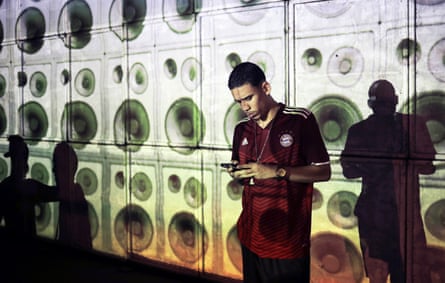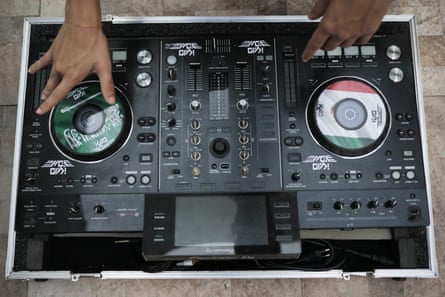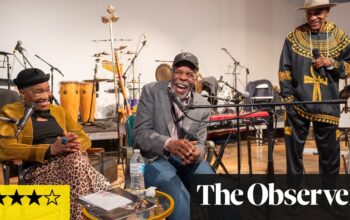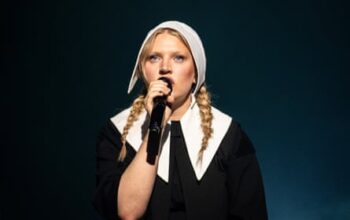I
At 4am on a Monday morning, the majority of Rio de Janeiro was in a state of slumber. However, in Morro do 77, a favela located on the tough west side of the city, the festivities were just beginning. Hundreds of partygoers crowded the main street of the community, showing off their moves in front of a booming wall of sound.
Loud favela funk music was blasting from the speakers and subwoofers, filling the morning air. Guests were enjoying small cups of whiskey and frozen coconut water. As they danced and moved to the beat, the name of the rave unexpectedly appeared on a screen in a bold display of red, blue, and white. It read, “The Baile de Londres,” also known as “The Party of London.”
“Sometimes people go straight to work afterwards,” said one of the DJs, Hyago Domingos de Lima, before his deafening setlist rendered conversation impossible.

The Sunday night extravaganza – where revelers, including someone sporting an England soccer jersey, boogied until 7am – is just one of many favela funk parties now themed after cities and countries across the globe.
Around five years ago, musicians from the Complexo do Lins, one of the biggest favelas in Rio, started a trend by creating the Baile da Colombia (Party of Colombia), which alludes to the ongoing conflict in the neighboring country and the deadly violence that plagues many gang-run regions in Rio.
Recognizing the potential of a non-local name to boost their brand recognition and draw in bigger crowds, event planners in favelas throughout the city grabbed their maps.
In Chapadão, their event was named after Egypt, while in Parque das Missões it was named after Poland, and in Parque Arará it was named after Portugal. One favela decided to represent China and used their national flag to promote their rave. Another favela chose to pay tribute to a local gangster nicknamed after Japan.
In the city of São Gonçalo, located east of Rio, event organizers chose cities in the United States, such as New York, Brooklyn, and Las Vegas. In Rocinha, they honored Russia with the Baile de Moscow. In Jacarezinho, they hosted the Baile de Paris.

Kaio Gonçalves da Silva, a 26-year-old DJ, stated that there is a funk party named after every country in the world. He performs at these parties under the names of Acapulco and Saudi Arabia in Duque de Caxias, a city north of Rio. He travels between the two gigs on his customized Sonic the Hedgehog motorbike, which only takes five minutes.
Da Silva, also known as DJ Kaio VDM, mentioned several countries including Canada, Libya, Korea, Croatia, Sweden, Italy, Ireland, and Scotland in his recent hit song honoring Brazilian and West Ham football player Lucas Paquetá.

According to DJ and producer Luiz Júnior, who is originally from the westside favela Vila Aliança, the local musicians chose to adopt Romania as their country. This decision was made when there were few options left. Júnior admits that he and many others in the area are unfamiliar with Romania and do not even know its capital. However, the Romanian flag’s colors were well-liked by the community. Júnior’s sound system, Ignorant, supplies large, custom-made speaker systems for events in countries such as Argentina, Mexico, and Iraq.
Lima, also known as DJ HG, created the Baile de Londres during a casual conversation with his friends Fatty Psycho, Haze, Xiclaudio, and Big Dave in Morro do 77’s main square. Initially, they thought about using Guatemala as the theme, but then someone suggested England. However, Lima explained that the Portuguese word for England (Inglaterra) was too long and difficult for MCs to say. Therefore, they decided on the Baile de Londres, a new Rio rave with a UK theme. The flyers for the event featured images of the Houses of Parliament and the London Eye.
Lima, who, like many residents of the favela, has not had the opportunity to travel internationally, acknowledged that his understanding of the capital of the UK was limited. “When I picture London, I imagine… the tall buildings and the lake with the bridge on top,” he commented, referring to Tower Bridge.
Marcelo Henrique dos Anjos da Silva, a dancer whose mesmerising dance steps at the Baile de Londres often go viral social media, associated London with little but the cold. “It’s the sort of place you need a jacket and a scarf,” Da Silva, whose nickname is ML, said as he sat in Morro do 77’s plaza in flip-flops and shorts.
The Brazilian favela now has a distinct British atmosphere with the establishment of the Party of London. The Retão de Londres, formerly known as Francisco Brício Avenue, has become the main street with a nod to London. The recently formed Seleção de Londres, also known as Team London, made it to the final of the favela’s yearly tournament in traditional English fashion but ultimately did not emerge victorious.
“They thrashed us: 4-0 or something,” said Pedro Gomes, one of the team’s defenders, as he showed off the favela’s synthetic pitch wearing his union-flag-branded kit.
Gomes, who is employed at a hospital pharmacy when not defending London’s goal, expressed that the baile (dance party) is a necessary source of recreation for the overworked residents of his impoverished neighborhood. “It’s a way for the locals to unwind and have fun, especially when they are constantly working. People need to relax and enjoy themselves too,” the 25-year-old stated as the large sound system for the event was being set up outside the Vida Em Graça (Life in Grace) church.

The funk music culture in Rio has frequently faced accusations and criticism from both authorities and critics for promoting drugs, violence, and sexual content. However, in recent times, it has gained more recognition as a valuable cultural asset and has even been honored in one of Brazil’s most prestigious art museums.
The events are an essential source of economic support for the favelas in Rio, where approximately 20% of the population resides. One day before the Baile de Londres began, Adriana da Silva Lucena left her residence in Vila Ideal favela to vend beverages at the Baile de Acapulco.
Lucena, a single mother of 51 years in a community where numerous families rely on benefits, stated, “Our lives are challenging and without the baile, many individuals would go hungry.”
“It can be exhausting and stressful,” she expressed about her overnight shifts. “But I have a deep love for this community. Acapulco is my entire livelihood, whether I like it or not.”
Wagner Oliveira, the 32-year-old proprietor of a clothing store in Vila Ideal named after the Mexican holiday spot, expressed: “Many people assume that bailes are all about drugs and drinking. However, these events actually bring many benefits to the community.”
After becoming a born-again Christian, Oliveira stopped going to raves and did not enjoy the music’s explicit lyrics. However, he acknowledged the significance of these parties in favela culture, stating that only those who live there truly understand their importance. Outsiders fail to comprehend it.
Shortly after, the sound level increased and revelers started to show up for a wild night of pleasure. Oliveira closed his store and went home, proudly displaying Mexico’s Aztec-themed flag in his storefront window with a message for potential customers. “Be back soon,” it read.
Source: theguardian.com


